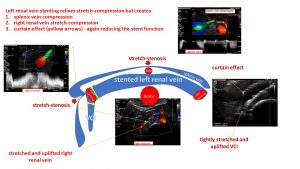
A 24 years old lady got a stent into her left renal vein to reduce her very painful pelvic congestion.
She ended up with inreasing pelvic pain, can neither stand or walk for more than 5 minutes.
The reason is: no improvement of the left renal vein’s transport capacity despite a stent who relieved her left renal vein compression.
But the same stent produced 3 new stretch-compressions.
- The vena cava was stretched ventrally by the stent which is elastic and thus pulls the vena cava ventrally. This produces a curtain effect in front of the right stent opening thus blocking the stent at its exit. Subsequently, no sufficient stent function was achieved. This can be shown by the PixelFlux measurement of both kidney’s perfusion

The stent is an elastic spring, pulling the vena cava ventrally. This stretches the vein and narrows the outflow from the stent, being responsible for the stent failure despite the stent is open.

PixelFlux measurements clearly show that the stent is not working properly despite opening the primary left renal vein compression.Theblood flow in the left kidneyy is only 23 % of the right one, thus producing a severe pelvic congestion.
2. The right renal vein is also stretched and thus stretch-compressed, producing an outflow obstruction of the right kidney
3. The splenic vein is now stretch-compressed due to the ventral uplifting of the superior mesenteric artery by the left renal venous stent



